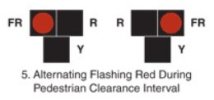This is nice having an audience rant to....
I see over and over where these smart traffic-actuated signals retard traffic movement to the greatest extent. This happens when the traffic volume is in-between light and heavy. I'll be coming up to an intersection where it will turn red in my face, requiring a fast stop. While I'm sitting there with a totally open intersection in front of me, I'll see a car coming to the intersection with a green. Just as he gets there his signal turns red in his face, and mine shortly goes green. This happens with both oncoming and side traffic.
Another way to describe it is that the signals cause every single car going through the intersection to first come to a full stop.
Generally the poor, inefficient operation you describe is the culmination of several practices: outdated and inaccurate data collected from the various traffic sampling stations, improper implementation of that data and poor equipment maintenance.
Just like our computers, if you feed them crap data, you get crap results...the old garbage in/garbage out.
Too many agencies dial in parameters and even if they work out great initially they don't revisit the operation weeks or months and in some cases years to see how it's working. It doesn't take an engineering degree to see that traffic is very dynamic and you can't "set it and forget it" unless you want it to operate as you described and we've all seen.
And it's not just the traffic engineers that initially designed the system that are shirking their responsibilities....it's the traffic engineers that are supposed to gather the data constantly, implement the timing and settings into the local traffic controllers and system coordination systems and the field (traffic signal) technicians that insure all the hardware is doing what it's supposed to do.
Of course budget cuts can play a role in the poor execution, as well as politics and these days, even DEI policies.
I fought what I described above from '73 to '04 and it drove me nuts. I would get so frustrated because in the overwhelming number of cases if people would just do their $%#* jobs things would work so much better. I've changed somewhat since I retired in '04 but for too, too many years I would takeover where someone would drop the ball because I could usually fix it or correct it in less time than it would take to get them to do their job. There have always been and there will always be, stupid, lazy and incompetent people that collect a paycheck regularly and create work for other people. Honestly I don't see how some people get to where they are having been around them for a time and seeing how they work....some are functional morons.
Way too many of them could drop off the face of the earth for 6 months and probably they would only be missed by their dog.
</END RANT>



